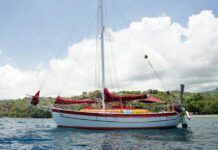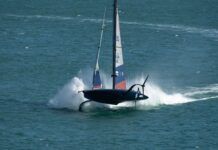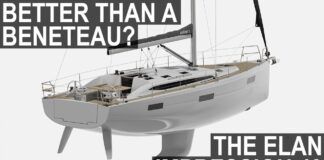Binoculars are an expensive but essential piece of marine safety gear. All skippers should keep a pair close at hand whenever they are at the helm—and for good reason. Being able to clearly identify any object that comes within range of your boat—be it a ship, raft, piece of flotsam, navigational marker, or a nearby shoreline—makes for a safer passage and better peace of mind.

288
Experience has shown that binoculars with a maximum magnification of 7x power are best suited for a boat’s rough-and-tumble motion. This magnification, coupled with a large 50-millimeter front lens, has proven to be the ideal setup for viewing distant objects from aboard a boat, especially in low-light conditions.
What We Tested
To narrow the field and keep things strongly competitive within the test group, PS elected to test only binoculars specifically suited to the rigors of the marine environment. We capped the price at $300, and chose only waterproof, 7×50 binoculars with internal compasses. The latter requirement was added because of its overall usefulness to the small boat navigator. We tested 10 units: from ProMariner, the High Seas RC, Gulfstream GS50, Gulfstream GS30, and Watersport RC; from Celestron, the Oceana; from Fujinon, the Mariner II; from Nikon, the Ocean Pro; from Olympus, the Magellan; from Swift, the Sea King; and from West Marine, the Tahiti. Redesigned binoculars from Bushnell were not available at press time. We plan a follow-up once these binoculars hit the market.
How We Tested
Several staff members used each pair of binoculars at two different locations. The first was a dock overlooking Sarasota Bay, Fla., during daylight and twilight hours. Testers used each pair of binoculars to view objects including passing boats and fixed day beacons less than 100 yards offshore. They also looked at distant navigational markers and a building-filled shoreline more than a mile away.
During the second outing, testers used each pair of binoculars aboard an unanchored boat with the engine running. They spied a set of day beacons from known distances, based on data from the vessel’s GPS, during daylight and twilight hours. As the last rays of sunlight gave way to darkness, testers remained aboard to use each set of binos to view some lighted navigational markers, a few passing boats, and a long shoreline. Some of the shoreline areas were filled with well-lit houses, while others were nothing more than a dark tangle of mangrove trees.
Comments about visual acuity (sharpness), color temperature, focusing, handling, eyecups, and compass use were noted. One tester, with known values for his slight myopia, tested the diopter scale on each set of binoculars for accuracy at his particular setting. Comments are noted in each section.
Each binocular manufacturer supplied specifications that we’ve listed on the accompanying chart.
The focusing rating includes the use of the center focus or individual eye focus (depending on how each product was equipped), the usefulness of the diopter adjustment, and the comfort and effectiveness of the eyecups (with and without eyeglasses). If a particular binocular performed well in all areas, it was rated Excellent. Deficiencies in one or more areas resulted in lower overall focusing ratings.
The handling rating takes into account the quality of the supplied case, comfort of the neck strap, each unit’s weight, ease of use of the lens caps, and the shape and grip of each pair. Our day/night viewing rating includes sharpness and how easy the compass is to use.
A waterproof test and a drop test were also conducted. These two tests were conducted with neck straps off, front lens caps on, and eyepiece caps off. To test the manufacturers’ claims of waterproofness, testers dunked each pair in salt water, rinsed them with a freshwater spray, and examined them for water intrusion. To test durability, testers dropped each pair from three feet high onto a fiberglass boat deck.
To determine whether there were any marked differences in magnification and clarity from long distances, testers viewed navigational marker numbering at 4,000 feet, 3,000 feet, and 2,500 feet. We could not definitively read the marker number with any of the binoculars until we reached 2,500 feet. At that distance, testers could clearly read the marker number with all the binoculars.
In the final analysis, we considered the ratings, price, and warranty of each pair of binoculars.
Celestron Oceana
This rather compact binocular stands about six inches tall, including the lens caps. Features include individual eye focus and a slide-rule style distance calculator on the left lens tube.
The diopter scale is on top of the eyepieces, rather than on the preferred bottom side. The Oceana was rated Fair for focusing. Testers found the index marks small and hard to see. The scale was slightly off, as well. When viewed with eyeglasses, the Oceana exhibited some loss of field of view and edge sharpness. Optical acuity was Good. The only viewing problem we noted was some difficulty seeing the compass, especially when wearing eyeglasses.
The supplied case offers good protection, but the neck strap is thin and lacks padding. The caps that cover the front objective lenses on the Oceana are attached between the lenses by a hinge. This is not our preferred method, but in this case, it proved to work well as the caps fit the lens tubes properly. They were easy to put on and remove, and were loose enough on the hinge to let gravity move them away from the front lenses.
The Oceana failed the drop test. Something in the right lens tube, possibly a prism or lens, came loose and rattled around inside. When we looked through the binoculars after the test, we saw a double image. Celestron did not respond when asked whether its lifetime warranty would cover such damage.
Bottom Line: A middle-of-the-pack binocular.
Fujinon Mariner II
The Mariner II sports a sleek look with a smooth, gray finish. It is the only pair of binoculars we tested equipped with a digital compass. The digital compass is much smaller and less obtrusive than the wet compasses on the other binoculars, making the grip on these much more comfortable. Unfortunately, the digital compass proved problematic during testing. We had trouble getting it to work, but new batteries solved that problem. Then, after the water dunking, the compass remained on and locked to a certain heading, which burned the batteries again. We tried unsuccessfully to revive it.
The Mariner II features center focus with a single diopter adjustment on the right eyepiece. PS testers preferred the center focus, finding it easier to use and easier to refocus on objects at varying distances. However, on this set, the center focus was a bit stiff. The Fujinon eyecups were not a favorite; most testers disliked their hard texture. Eyecups on the Mariner II could be turned easily, but they would not stay in a center position, and when you hit the limit, they would usually upset the diopter adjustment.
The Mariner II was one of three binoculars to receive an Excellent rating for viewing. It was clear, sharp, had no color aberrations, and had an easy-to-read compass.
No case is supplied, but other handling issues were rated Good. The strap has a large neck pad that doubles as flotation, and the center-hinged front lens caps fit well and were easy to use.
The Mariner II binoculars failed the drop test. Something went out of alignment in the right lens tube, causing users to see a double image. The Fujinon warranty covers only manufacturer defects; so any damage from dropping the binos would not be covered.

288
Bottom Line: It performed well, but we don’t like the Fujinon Mariner II’s temperamental digital compass and uncomfortable eyecups.
Nikon Ocean Pro
The Nikon Ocean Pro shares the same sleek look and smooth gray finish as the Fujinon binoculars. Even though the Ocean Pro uses a wet compass, it is one of the smallest and least obtrusive in the group and makes this pair of binoculars easy to grip and comfortable to hold.
Like the Fujinon Mariner II, the Ocean Pro has a center focus with a single diopter adjustment on the bottom of the right eyepiece that testers found somewhat stiff. The Nikon Ocean Pros provided a top-quality image during the day and at night, and received an Excellent for viewing. The compass was easy to see, with and without eyeglasses.
Nikon supplies a nice case with the Ocean Pro. The neck strap is identical to the Fujinon’s and doubles as flotation. The front lens caps, anchored with a center hinge, fit well and are easy to use.
After dunking the Nikon Ocean Pro, testers noticed numerous water droplets inside the sealed area of the left lens tube. We contacted Nikon about this failure. The company said the test indicated this particular set of binoculars was defective. Under Nikon’s no-fault 25-year warranty, this unit would be replaced. Nikon also sent us another set to test. We dunked the new pair as soon as it arrived and found no evidence of water intrusion.
Bottom Line: A top performer with added features and a 25-year warranty, the Ocean Pro is the PS Best Choice.
Olympus Magellan
A mid-size binocular, the Olympus Magellan features individual eye focus and a smooth, dark blue plastic armor finish.
The diopter scale is located on the preferred bottom side of the eyepieces with index and scale marks molded into the plastic. When used with eyeglasses, the Magellan exhibited a significant field of view loss. We found its sharpness Good; the compass, however, is difficult to see when wearing eyeglasses.
The strap supplied with the Magellan is identical to the Fujinon and Nikon straps. It offers plenty of neck padding that also serves as flotation. The Olympus-supplied case is too small to hold the binoculars and strap. We’d prefer a harder case for better protection.
The front lens caps attach to the center hinge. We found their fit very tight and difficult to remove.
Bottom Line: Good optical performance coupled with a reasonable price and a lifetime warranty make the Olympus binos a good choice—but not the best.
Promariner High Seas RC
Another of the compact binoculars, the High Seas RC stands just over six inches high when resting on the objective lens caps.
The High Seas RC has center focus with a diopter scale on the bottom of the right eyepiece. Index and scale marks are molded into the plastic. The diopter scale was slightly off. Optical acuity of the High Seas was Good. We had difficulty seeing the compass when wearing eyeglasses.
Three ProMariners—the High Seas RC, Gulfstream GS50, and Watersport RC—have magenta-coated lenses, giving images a cool (color temperature), bluish tint. The company says the tinting reduces the glare from water and other surfaces that refract sunlight.
The supplied case is too soft and offers minimal protection, in our opinion. The provided neck strap has a small pad, but no flotation, and this pair needs flotation. It was the only binocular to sink during our dunk test. Front lens caps are attached at the center. The caps fit the lens tubes properly, are easy to put on and remove, and are loose enough on the hinge that they stay out of the way of the front lenses. One cap had a distance calculator inside.
In the drop test, though not readily apparent, something was thrown out of alignment just enough to make looking through these binos cause eye discomfort. The warranty would not cover the damage, according to ProMariner, because it covers only manufacturer defects.
Bottom Line: Another middle-of-the-pack binocular with a three-year warranty.
ProMariner Gulfstream GS50 and GS30
These two pairs of compact binoculars are nearly identical. Their squat design measures six inches high when resting on the front lens caps.
Both Gulfstreams have individual eye focus with the diopter scale on the top of the eyepieces. Index marks were painted on the eyepiece, and on the GS30 test model, one paint mark was smeared, making it hard to use accurately. Index marks were printed on the housing. The diopter adjustment on both sets was stiff enough to require two fingers to fine tune. Both binoculars suffered a significant loss of field of view when used with eyeglasses. Optical acuity of the ProMariner pair was Good; however, the compass was hard to see with and without eyeglasses. One glitch we noticed was an out-of-focus reticle when the binoculars were focused on a distant object.
In our opinion, the cases supplied with these binoculars offer minimal protection. The neck straps had small pads, but offered no flotation. Front lens caps, attached to center hinges, fit the lens tubes properly and are easy to put on and remove. The left lens tube on the GS50 has a sliding scale distance calculator.
Bottom Line: Mediocre ratings.
ProMariner Watersport RC
The Watersport RC resembles the Nikon and Fujinon binoculars. It features a sleek look with a soft, smooth yellow finish.
Watersport RC is equipped with center focus and a single diopter adjustment on the bottom of the right eyepiece. As with several other center-focus binoculars, the mechanism on the Watersport was a little stiff near one end of the travel limit. Some field of view loss as well as difficulty seeing the compass was noted when the Watersport binoculars were used with eyeglasses. Optical acuity on these binoculars was Good.
The case supplied with the Watersport RC offered good protection. It has a double-zipper top with a large flap cover. We especially liked the Watersport lens caps. They hinge on the bottom of the lens tube, making them very easy to flip out of sight.
Bottom Line: A nice pair of binoculars with a sleek look and several value-added features, the Watersport RC is our Budget Buy despite its short warranty.
Swift Sea King
Sea King from Swift has a traditional look with its black, stepped armor. Features include individual eye focus, front lens caps secured to the center hinge, and a neck strap with wide nylon webbing.
The diopter scale on the Sea King is on the bottom of the eyepieces with index and scale marks molded into the plastic. Some loss of field of view was noted when the user wore eyeglasses. The compass also was difficult to see for eyeglass wearers. Optical acuity of the Sea King binoculars was Good.
A significant portion of the strap is wide nylon webbing and makes for comfortable carrying, though it offers no flotation. The case was about average, offering minimal protection. Front lens caps, with center hinge, fit rather tightly and were hard to remove.
Bottom Line: Ruggedly built with traditional looks, the Sea King performed about average.
West Marine Tahiti
West Marine’s Tahiti has a bright blue-and-black plastic armor finish. Tahiti features center focus with a single diopter adjustment on the bottom of the right eyepiece. Testers reported that the center-focusing mechanism worked smoothly throughout its range.
The Tahiti received an Excellent rating for day/night viewing. It provided a clean, sharp image. We found the field of view loss with eyeglasses to be minimal, but the compass was difficult to read depending on eye position.
The Tahiti front lens caps are hinged on the bottom of each lens tube, making them easy to open and close and keeping them out of the way when the binoculars are in use. The provided case offers only minimal protection. The neck strap was fitted with a small neck pad, but no flotation.
Bottom Line: A top performer with excellent handling, a lifetime warranty, and rugged construction, the Tahiti is highly recommended.
Conclusions
During testing, we came to see, literally, that this group of binoculars is extremely close in basic optical performance. Differences didn’t start to appear until we got picky about how easy the compass was to read or exactly how well a center-focus operated. Testers favored center focus binoculars over those with individual eye focus, and we believe it is easier to use for most people.
It was interesting to note that typical navigation markers could be identified by shape at quite long distances. But when it comes time to read the marker numbers, you’d best be within about 2,500 feet. In low-light conditions, this distance dropped rapidly until in total darkness it became impossible to read numbers until we were very close to the markers.
The Nikon Ocean Pro garnered our Top Choice award by doing very well in the performance categories and by carrying an excellent warranty. We also highly recommend the West Marine Tahiti, another top performer. These two binoculars also were named top picks and best buys in PS’s 2003 binocular test, which was published Aug. 1, 2003.
Contacts
• Celestron, www.celestron.com/c2/, 310/803-5955 (tech support)
• Fujinon, www.fujinon.com, 973/633-5600
• Nikon, www.nikonusa.com, 800/645-6687
• Olympus, www.olympusamerica.com, 800/622-6372
• ProMariner, www.pmariner.com, 603/433-4442
• Swift, www.swift-optics.com/, 800/523-4544
• West Marine, www.westmarine.com, 800/685-4838








































